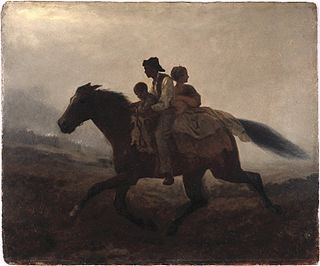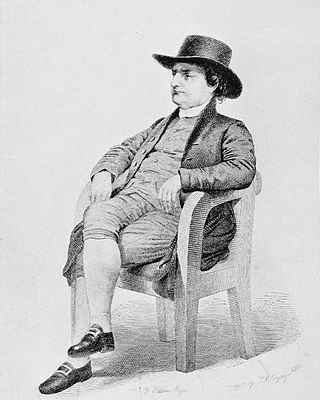Guinea Town is an early free Black community that was formed with the help of Hicksite Quakers in Old Westbury, New York in 1793 and remained active until just after the Civil War. [1] [ failed verification ]
Guinea Town is an early free Black community that was formed with the help of Hicksite Quakers in Old Westbury, New York in 1793 and remained active until just after the Civil War. [1] [ failed verification ]
Guinea Town played a part in transporting runaway enslaved Africans to Dartmouth, Nova Scotia, which was a Quaker community. Eliakim Levi was a leader in the Black community of Guinea Town, in New York and a conductor with the Hicksites on the Underground Railroad. Hicksites were Quakers who were followers of Elias Hicks. The Hicks family gave land to establish Guinea Town, the early free black community in Old Westbury, New York. [2] [3]
Elias Hicks was instrumental in ensuring the opening, on April 27, 1817, of a primary school and Sunday school for Blacks in the Westbury neighborhood then known as Guinea Town, near today's Glen Cove Road and the southwestern corner of the access road to the Long Island Expressway. By 1830, the community had its own church. [2]
In 2005 the Black Ice Project/Underground Railroad project was created to identify connections between slavery, safe houses in Brooklyn, transit through Guinea Town, and ex-slaves who played hockey in Canada. The project works to identify Quaker families, free Africans and runaway slaves who were part of the 1800s underground railroad network. [4]

The Underground Railroad was a network of secret routes and safe houses established in the United States during the early to mid-19th century. It was used by enslaved African Americans primarily to escape into free states and from there to Canada. The network, primarily the work of free African Americans, was assisted by abolitionists and others sympathetic to the cause of the escapees. The slaves who risked capture and those who aided them are also collectively referred to as the passengers and conductors of the Railroad, respectively. Various other routes led to Mexico, where slavery had been abolished, and to islands in the Caribbean that were not part of the slave trade. An earlier escape route running south toward Florida, then a Spanish possession, existed from the late 17th century until approximately 1790. However, the network generally known as the Underground Railroad began in the late 18th century. It ran north and grew steadily until the Emancipation Proclamation was signed by President Abraham Lincoln. One estimate suggests that, by 1850, approximately 100,000 slaves had escaped to freedom via the network.

Jericho is a hamlet and census-designated place (CDP) in the Town of Oyster Bay in Nassau County, on the North Shore of Long Island, in New York, United States, approximately 29 miles (47 km) east of Midtown Manhattan. The population was 14,808 at the time of the 2020 census.

Levi Coffin was an American Quaker, Republican, abolitionist, farmer, businessman and humanitarian. An active leader of the Underground Railroad in Indiana and Ohio, some unofficially called Coffin the "President of the Underground Railroad," estimating that three thousand fugitive slaves passed through his care. The Coffin home in Fountain City, Wayne County, Indiana, is a museum, sometimes called the Underground Railroad's "Grand Central Station".

In the United States, fugitive slaves or runaway slaves were terms used in the 18th and 19th centuries to describe people who fled slavery. The term also refers to the federal Fugitive Slave Acts of 1793 and 1850. Such people are also called freedom seekers to avoid implying that the enslaved person had committed a crime and that the slaveholder was the injured party.

Elias Hicks was a traveling Quaker minister from Long Island, New York. In his ministry he promoted unorthodox doctrines that led to controversy, which caused the second major schism within the Religious Society of Friends. Elias Hicks was the older cousin of the painter Edward Hicks.

The Religious Society of Friends began as a proto-evangelical Christian movement in England in the mid-17th century in Ulverston. Members are informally known as Quakers, as they were said "to tremble in the way of the Lord". The movement in its early days faced strong opposition and persecution, but it continued to expand across the British Isles and then in the Americas and Africa.

Thomas Garrett was an American abolitionist and leader in the Underground Railroad movement before the American Civil War. He helped more than 2,500 African Americans escape slavery.

Isaac Tatem Hopper was an American abolitionist who was active in Philadelphia and New York City in the anti-slavery movement and protecting fugitive slaves and free blacks from slave kidnappers. He was also co-founder of Children's Village with 23 others.

The Religious Society of Friends, better known as the Quakers, played a major role in the abolition movement against slavery in both the United Kingdom and in the United States. Quakers were among the first white people to denounce slavery in the American colonies and Europe, and the Society of Friends became the first organization to take a collective stand against both slavery and the slave trade, later spearheading the international and ecumenical campaigns against slavery.

Isaac and Amy Post, were radical Hicksite Quakers from Rochester, New York, and leaders in the nineteenth-century anti-slavery and women's rights movements. Among the first believers in Spiritualism, they helped to associate the young religious movement with the political ideas of the reform movement.

The Underground Railroad in Indiana was part of a larger, unofficial, and loosely-connected network of groups and individuals who aided and facilitated the escape of runaway slaves from the southern United States. The network in Indiana gradually evolved in the 1830s and 1840s, reached its peak during the 1850s, and continued until slavery was abolished throughout the United States at the end of the American Civil War in 1865. It is not known how many fugitive slaves escaped through Indiana on their journey to Michigan and Canada. An unknown number of Indiana's abolitionists, anti-slavery advocates, and people of color, as well as Quakers and other religious groups illegally operated stations along the network. Some of the network's operatives have been identified, including Levi Coffin, the best-known of Indiana's Underground Railroad leaders. In addition to shelter, network agents provided food, guidance, and, in some cases, transportation to aid the runaways.

The free-produce movement was an international boycott of goods produced by slave labor. It was used by the abolitionist movement as a non-violent way for individuals, including the disenfranchised, to fight slavery.
William Parker was an American former slave who escaped from Maryland to Pennsylvania, where he became an abolitionist and anti-slavery activist in Christiana. He was a farmer and led a black self-defense organization. He was notable as a principal figure in the Christiana incident, 1851, also known as the Christiana Resistance. Edward Gorsuch, a Maryland slaveowner who owned four slaves who had fled over the state border to Parker's farm, was killed and other white men in the party to capture the fugitives were wounded. The events brought national attention to the challenges of enforcing the Fugitive Slave Law of 1850.

Lucretia Mott was an American Quaker, abolitionist, women's rights activist, and social reformer. She had formed the idea of reforming the position of women in society when she was amongst the women excluded from the World Anti-Slavery Convention held in London in 1840. In 1848, she was invited by Jane Hunt to a meeting that led to the first public gathering about women's rights, the Seneca Falls Convention, during which the Declaration of Sentiments was written.

Bethel African Methodist Episcopal Church is a historic African Methodist Episcopal Church in Springtown, New Jersey, United States. The church was part of two free negro communities, Othello and Springtown, established by local Quaker families, like the Van Leer Family. The congregation was established in 1810 in Greenwich Township as the African Methodist Society and joined the African Methodist Episcopal Church in 1817. A previous church building was burned down in the 1830s in an arson incident and the current structure was built between 1838 and 1841.

The Quakers have had a presence in Canada since 1670, when Charles Bayly was sent to be the governor of the Hudson's Bay Company. Early Quaker settlements were attempted in New Brunswick, Nova Scotia, Prince Edward Island and at Farnham in Quebec in the late 1700s. Permanent communities were realised at Adolphustown on the Bay of Quinte and at the same time at Pelham in the Niagara District before 1800. Quakers immigrated to Canada from New York, the New England States, and Pennsylvania.

Joy Chatel was a cosmetologist, community organizer and activist based in Brooklyn, New York. She fought battles against the Bloomberg administration and millionaire developers to keep the history of anti-slavery organizing from being erased from the Fulton Mall area.
Isaac Hicks was a Quaker merchant, active in the mercantile and shipping business from 1790 to 1807, both by himself and in partnerships. Hicks Nursery in Westbury, New York is still in business to this day, and its site is landmarked.

Abolitionist Place is an alternative name for a section of Duffield Street in Brooklyn, New York City, which was a significant site of abolitionist activity in the 19th century. Abolitionists Harriet and Thomas Truesdell lived at 227 Duffield Street, which is believed to have been a stop on the Underground Railroad. William Harned, an Underground Railroad conductor, lived at the intersection with Willoughby Street, and stories have been passed down orally of involvement of several houses on the block. Duffield Street is said to be named for John Duffield, a Brooklyn resident and surgeon during the American Revolutionary War.